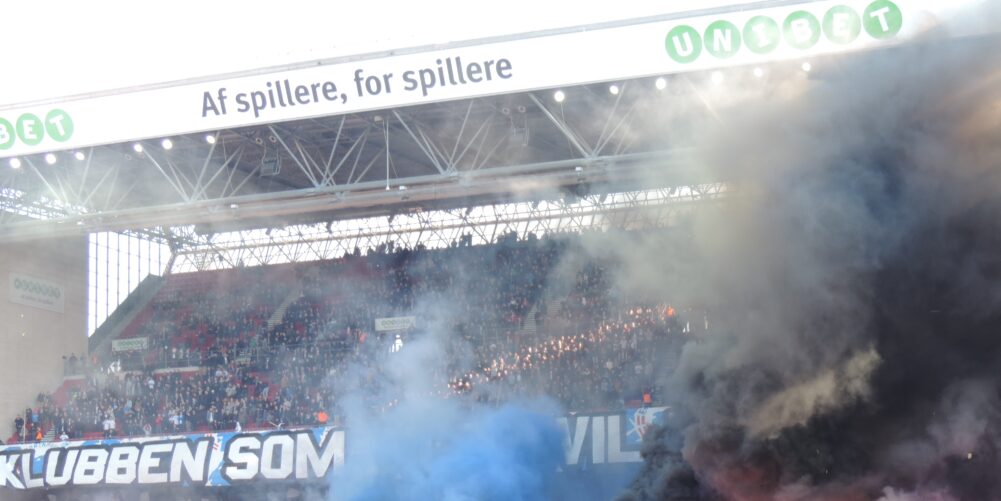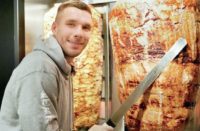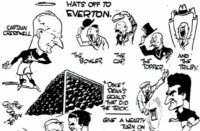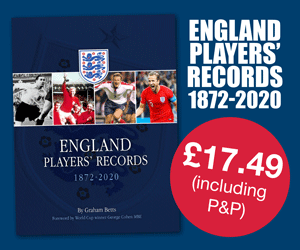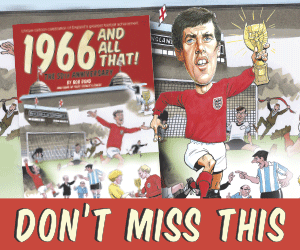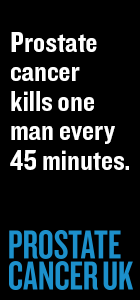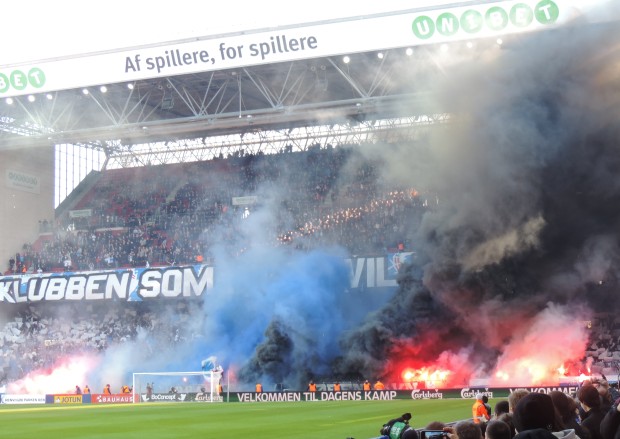 by Adam Michie
by Adam Michie
Think fierce European derby matches and you probably won’t look much further than North London, Glasgow, Rome or perhaps Istanbul. In an unassuming, almost forgotten corner of Europe however, wedged between the North Sea and the Baltic, two of the continent’s less recognised teams clash in a firecracker of an occasion.
The picturesque coastal city of Copenhagen is an often overlooked destination on the European map. It has a familiar western aesthetic but a self-assured ambivalence to life’s troubles that results in a wonderfully laid-back pace of life. To say Copenhagen is a quiet backwater, however, would do a disservice to a city that was once at the heart of Europe’s commercial superhighway and is steeped in as much history and tradition as many of the continent’s larger metropolises.
The difference between them and their continental counterparts, it seems, is that the Danes don’t feel the need to shout about it. They have perfected the art of taking a few otherwise mundane things and making them incredible. Bacon, beer, pastries and multicoloured
building blocks being their most recognisable gifts to mankind.
This same attitude is reflected in their football. Despite a dearth of Danish success at
club level, the national side’s surprise triumph at Euro 92 (after initially failing to qualify and being reinstated in war-torn Yugoslavia’s place) is testament to a nation who, while content to sit at the fringes, dares you to underestimate them.
The Copenhagen derby, known locally as the ‘New Firm’, pits FC Kobenhavn (Copenhagen
in English) against Brondby IF.
In their current guise FCK have only been around since the summer of 1992 and, on the
face of it, appear to be the new kids on the block in relation to their cross city rivals.
In reality, FCK is an amalgamation of two older clubs, one of whom, Kjøbenhavns Boldklub
(KB), is the oldest club in continental Europe. Between KB and Boldklub 03 (FCK’s other parent club), these capital clubs dominated the first six decades of the Danish championship, winning 22 between them.
By contrast, Brondby, based at Vilfort Park, about 15kms outside the city centre, though founded in 1964, are a modern success story. Emerging from amateur roots in the Danish sixth tier, the club took the championship (and the Superliga, founded in 1991) by storm, winning ten titles between 1985 and 2005.
Since then, however, the tide has certainly been in FCK’s favour with the the Lions taking
the crown six times. This tug of war between the two capital sides has fostered a mutual dislike and, like two siblings occupying the same bedroom, proximity, shared culture and the thirst for one-upmanship all comes to boiling point whenever they meet.
In an odd way, the football match itself is almost a sideshow to the main event played out
in the stands. On a sunny Sunday afternoon in early March, small bunches of spectators
dressed variously in white, blue and black and draped in scarves, began to snake their way
towards the Telia Parken stadium, home of FCK since their rebirth in 1992.
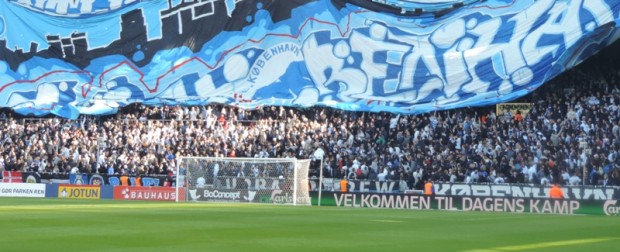 With over an hour to kick off the show had already begun. To our right, a two-tier stand, the lower of which was packed out with white shirts, flags and banners. To our left, almost too
With over an hour to kick off the show had already begun. To our right, a two-tier stand, the lower of which was packed out with white shirts, flags and banners. To our left, almost too
close for comfort, a single tier stand backed by a wall of glass was awash with bright yellow, like the sulphurous mouth of a volcano; and no less volatile.
The two banks of fans, separated by 100 yards of grass, faced off, seemingly taking it in
turns to send orchestrated roars of noise in each other’s direction.
As kick-off approached the decibels and the showmanship moved up a few gears. By now
both tiers to our right were full and a giant banner had been unfurled, obscuring the entire lower section.
The Brondby end took this as their signal to break out the flares. The mass conflagration was then joined by giant flags displaying the Brondby wishing well motif that, although being expertly wielded, were wagging dangerously close to the burning flares beneath them.
By now the players had trooped onto the pitch, at which time the giant banner in the FCK end dropped to reveal a perfectly assembled human mosaic of colour as fans held up card and the club’s lion head crest at the centre. This received a cacophonous roar of
appreciation from the adjacent stands as cries
of “FC Ko” rang round the tightly packed sides of the stadium.
Across the front of the stand more flares erupted into life, sending clouds of smoke billowing across the pitch, causing the players, who had been busy warming up, to disappear from view.
The Brondby fans made a late play for supremacy, shooting lengths of yellow and blue streamers and ticker tape high into the air and down onto the goalmouth, leaving the penalty area looking like the aftermath of a particularly ostentatious wedding.
Between the smoke cloud lifting and the time it took for the Brondby players to clear the debris left littering the pitch by their own fans, the kick off was now 15 minutes behind schedule. No one seemed to care.
It is so often the case that in many of the biggest derbies in Europe the game itself fails to live up to the theatre of the pre-match fireworks. Not on this occasion.
The hosts were well on top for most of the game and scored a couple of stunning goals – one a 25-yard half volley – as they ran out 3-1 winners. They were far from having it all their
own way, however.
A Brondby equaliser just after half-time sent the yellow army to our left into something akin to a berserker charge, as a writhing wall of humanity surged down towards the pitch, raising a few pulses amongst the high-vis stewards amassed around the advertising
hoardings.
In stark contrast to the tranquility we had left behind in the centre of town, those that had only hours before been peacefully riding bikes or sipping a coffee by the harbour had
been transformed. This proud Viking nation may lay dormant but the wild underbelly, so evocatively displayed on the terraces, is never far from the surface.
Amid all the bravura and posturing, the real beauty of this derby was that it rarely felt
threatening. There was hatred there, no doubt, and the desire to win was unquestionable but this was all played-out in a kind of ritualistic capoeira that lands no blows but expresses all the passion and pride of battle.
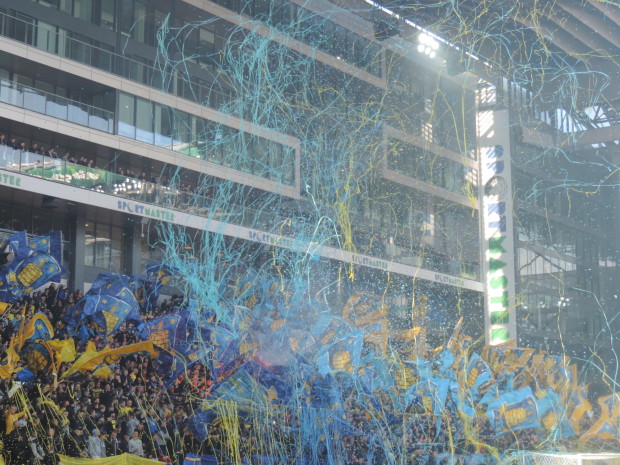 There was no overzealous marshalling. No heavy police presence. Drinking and smoking at pitch side was permitted and standing for the full 90 minutes a necessity.
There was no overzealous marshalling. No heavy police presence. Drinking and smoking at pitch side was permitted and standing for the full 90 minutes a necessity.
All this for the modest sum of £15. It was a breathtaking and awe-inspiring event that
made me mournful at the sanitisation our own game has suffered.
Denmark should be proud of a lot of things but by their very nature they prefer to let their
actions and deeds speak for themselves.
Their most famous boast is the claim to brewing probably the best lager in the world. That is open to debate but what they can quite confidently proclaim is that Copenhagen has probably the best derby in Europe.
*This article was originally published in Issue 29 Late Tackle – April 2015

